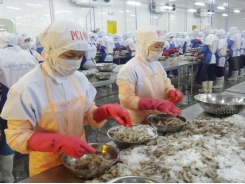New sources of omega-3 safe to use in fish feed

Amount of fish oil derived from wild fish not enough to meet needs of growing population and aquaculture industry, so new sources are needed.
The demand for fish oil rich in omega-3 fatty acids has long been greater than the supply. Sources that can meet the requirement for omega-3s in the diet of farmed fish have been scarce until now, according to an announcement from Nofima, a leading research institute in the areas of fisheries, aquaculture and food science.
However, new omega-3 sources are partly on the market, and research shows that these are safe to use in farmed salmon feed, Nofima said.
Nofima scientists recently tested two new sources. One is canola oil extracted from a rapeseed plant that was genetically modified to produce the omega-3s docosahexaenoic acid (DHA) and alpha-linolenic acid. The other is the microalgae Schizochytrium sp., which is not genetically modified but naturally rich in DHA. These sources are partially available on a commercial scale, the announcement said.
Nofima said the results show that both products provide good performance, quality, fatty acid composition and health for the salmon.
Both people and fish require the long, marine omega-3s eicosapentaenoic acid (EPA) and DHA to maintain good health; however, the amount of fish oil derived from wild fish is not enough to meet the needs of a growing population and aquaculture industry, Nofima explained. Therefore, several sources of marine omega-3 fatty acids are needed. Some omega-3s are used in health food products, some in animal feed and a large proportion in feed for farmed fish.
Omega-3 levels in Norwegian farmed salmon have fallen previously, and the lower limit is now assumed to have been reached. This trend can be stopped by utilizing new sources, Nofima said.
The aim of the research project “New Omega-3 Sources in Salmon Feed,” was to obtain scientific evidence regarding new feed sources and their effect on fish performance, quality and health.
Nofima carried out feeding trials using canola oil in salmon diets both in freshwater and seawater land-based fish tanks in Norway. Canola oil was added to the feed in increasing amounts. A parallel feeding trial has also been carried out on juvenile salmon in warmer water in Australia to test canola oil at two different growth rates. This was important in order to detect any effects that might occur when fish grow rapidly during early stages of life.
Nofima also carried out feeding trials in which salmon were fed microalgae from when they weighed 100 g to when they reached their slaughter size.
The salmon fed the new ingredients were analyzed for growth, composition, muscle quality and health, Nofima said. One of the purposes of the microalgae trial was to look at sensory parameters such as odor and taste.
“We know that salmon need the fatty acids EPA and DHA in order to maintain good health. This research shows that salmon can utilize these fatty acids both from the new sources of omega-3 and from fish oil in the same way," said project manager Bente Ruyter, a senior scientist at Nofima.
According to the announcement, the main findings are:
* Canola oil has a favorable fatty acid profile compared to conventional plant oils, with high levels of the omega-3 fatty acids alpha-linolenic acid and DHA. An analysis of a number of health markers suggests that this is a safe source of oil in salmon feed.
* Canola oil in salmon feed in both freshwater and seawater provided equivalent growth rates as fish oil and better skin and muscle color.
* Environmental pollutants could not be detected in salmon fed canola oil.
* Biomass from the algae Schizochytrium sp. is a good source of DHA in the diet of salmon and also contributes to better muscle color. This ingredient created no differences in the odor and flavor of the fillet compared to salmon fed fish oil.
Global challenge for aquaculture industry
Access to a greater volume of feed ingredients rich in omega-3s is considered one of the major challenges regarding growth in the global aquaculture industry, Nofima said.
“It now looks like there are solutions, but it will also be important in the future to utilize sources of omega-3 in fish as optimally as possible,” Ruyter said.
The assessment of whether oil from genetically modified rapeseed can be permitted for use in feed in Europe depends on government regulations. Only then will the industry be able to decide whether to use canola oil. Knowledge gained from this project will contribute to this assessment, Nofima said.
The findings were published in the article "Omega-3 Canola Oil Effectively Replaces Fish Oil as a New Safe Dietary Source of Docosahexaenoic Acid (DHA) in Feed for Juvenile Atlantic Salmon" in the British Journal of Nutrition.
Có thể bạn quan tâm
Phần mềm

Phối trộn thức ăn chăn nuôi

Pha dung dịch thủy canh

Định mức cho tôm ăn

Phối trộn phân bón NPK

Xác định tỷ lệ tôm sống

Chuyển đổi đơn vị phân bón

Xác định công suất sục khí

Chuyển đổi đơn vị tôm

Tính diện tích nhà kính

Tính thể tích ao hồ



 Vietnam partners with Dutch consortium to improve shrimp…
Vietnam partners with Dutch consortium to improve shrimp…  Price of raw material shrimp rise again
Price of raw material shrimp rise again